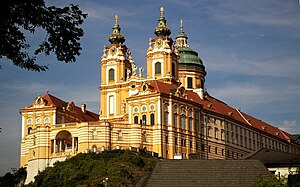Wachau
| Wachau Cultural Landscape | |
|---|---|
| Name as inscribed on the World Heritage List | |
 Melk Abbey 
|
|
| Location | Austria |
| Type | Cultural |
| Criteria | ii, iv |
| Reference | 970 |
| UNESCO region | Europe and North America |
| Inscription history | |
| Inscription | 2000 (24th Session) |
The Wachau (German pronunciation: [vaˈxaʊ]) is an Austrian valley with a picturesque landscape formed by the Danube river. It is one of the most prominent tourist destinations of Lower Austria, located midway between the towns of Melk and Krems that also attracts "connoisseurs and epicureans" for its high-quality wines. It is 40 kilometres (25 mi) in length and was already settled in prehistoric times. A well-known place and tourist attraction is Dürnstein, where King Richard the Lion-Heart of England was held captive by Duke Leopold V. The architectural elegance of its ancient monasteries (Melk Abbey and Göttweig Abbey), castles and ruins combined with the urban architecture of its towns and villages, and the cultivation of vines as an important agricultural produce are the dominant features of the valley.
The Wachau was inscribed as "Wachau Cultural Landscape" in the UNESCO List of World Heritage Sites in recognition of its architectural and agricultural history, in December 2000.
Even before the Neolithic period brought in changes in the natural environment of the valley, Palaeolithic's records of the valley have been identified in the form of "figurines" in Galgenberg and Willendorf stated to be 32,000 years and 26,000 years old respectively that testify to human occupation in the valley. It has been inferred that Krems and Melk were well settled establishments in the early Neolithic period between 4500 BC and 1800 BC. Wachau Valley's ancient history in the Neolithic period started with deforestation by the people of the land for cultivation and settlement.
...
Wikipedia
